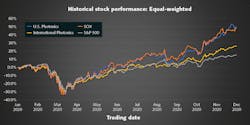Rather than presenting research data on various photonics market segments as the other presenters, John Dexheimer took a new and proactive approach. As a long-time investment banker, he has developed two photonics stock indices, published in Laser Focus World since June 2020. At the 2021 Lasers & Photonics Marketplace Seminar, he explained how the indices were set up and what benefits the photonics community can derive from them.
The actual motivation for such an index is multifold: First, it may draw investor attention to the sector and its firms, which could potentially enhance capital flows into this sector. Finally, it may serve investors as well as market participants as a framework to analyze trends in the market and have a real-time predictive tool. Dexheimer mentioned several other indices for comparison, such as the NASDAQ-Philadelphia Stock Exchange Semiconductor Index (SOX), the NASDAQ Biotechnology Index (NBI), and the Total 3D Printing Index. The most related appears to be the SOX, even if the semiconductor industry is structured quite differently.
Dexheimer developed two different indices for the photonics market: one for the U.S. market and another for international photonics. He selected 41 U.S. firms and 50 non-U.S. firms, based on headquarters’ locations, to ensure a focus on the global nature of the sector. $500 million market capitalization was used as a lower limit to focus on adequately capitalized firms capable of growing and to get consistent analysts and institutional investor attention. For the global photonics index, he used a broad set of parameters to reflect the photonics demand drivers and investments.
It was quite interesting to look at the performance metrics. In 2020, the U.S. photonics index behaved almost similar to the SOX, while both outperformed the S&P 500 (see figure). International photonics was doing worse than the U.S. photonics, but still better than the S&P 500. Some individual companies within the index performed very well with up to 400% gains in 2020. On the other end of the list were two companies (Coherent and FLIR), which are now to be acquired in 2021.
At the end of his presentation, Dexheimer wondered how this project should proceed. Certainly, there would be adds and drops in the list of indexed companies to reflect economic developments. For example, the companies acquired in 2021 would disappear in the index. At the same time, a good number of companies would qualify for addition. For smaller companies with less than $500 million market cap, he may propose starting a small cap index.
One challenge for future index development is the current capitalization of lidar firms. Currently, there are five lidar companies that are going public through special-purpose acquisition company (SPAC) mergers. With $150 million of combined revenue, they are valued at over $20 billion in total. If introduced, Dexheimer wonders if that would create a bias toward hyper-growth? Or should there be some other parameters that say, unless the company has been public for a year, it shouldn't be included in the index? Dexheimer thinks that these are interesting points to debate.
One way to get the idea of the index into the economic realm would be an exchange traded fund (ETF). Such a fund could reflect the index and would be traded on the stock exchange. In the subsequent Q&A session, Dexheimer was asked about starting such a photonics ETF; he admitted that he talked to some ETF providers just recently. It seems worth it to make it an actively managed fund, which is a full-time job. Furthermore, it requires a lot of regulatory effort as well as substantial initial investments. Dexheimer would not embark on that, but he thinks it may be the right time to launch a photonics ETF.
CONTINUE READING >>>
About the Author
Andreas Thoss
Contributing Editor, Germany
Andreas Thoss is the Managing Director of THOSS Media (Berlin) and has many years of experience in photonics-related research, publishing, marketing, and public relations. He worked with John Wiley & Sons until 2010, when he founded THOSS Media. In 2012, he founded the scientific journal Advanced Optical Technologies. His university research focused on ultrashort and ultra-intense laser pulses, and he holds several patents.

